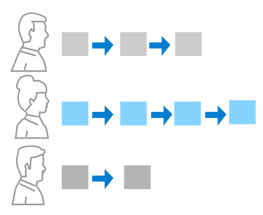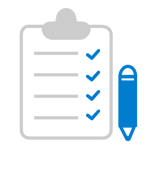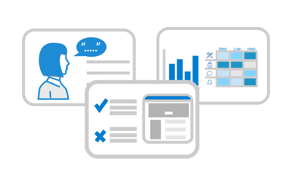Accessibility research enables us to create products with empathy by ensuring they’re usable by all people regardless of age or ability. According to the last U.S. Census, nearly 1 in 5 Americans have a disability. At 20% of the population, creating accessible experiences for all audiences with disabilities whether visual, auditory, or cognitive, is more than just a legal requirement. Failing to consider accessibility excludes millions of people from using your product and can make or break your success in the larger digital world.
Here at AnswerLab, inclusivity is a central part of our mission and core values. It’s something we prioritize both internally for our employees and externally with our clients and projects. Accessibility testing can be daunting, but it’s crucial to better understanding your product’s reach in the world. Over the years, as we’ve grown our expertise in accessibility research, we’ve developed a number of best practices. Here are a few we follow to structure the research process from start to finish when it comes to testing with specialized populations and user needs.
Think deeply about how people with disabilities may experience using your product.
 To start, consider your product and what parts of it might present challenges for people with disabilities. Be especially thoughtful about what some users might experience and how that differs from your own use of the product. This helps you and your team build empathy and determine who you need feedback from.
To start, consider your product and what parts of it might present challenges for people with disabilities. Be especially thoughtful about what some users might experience and how that differs from your own use of the product. This helps you and your team build empathy and determine who you need feedback from.
To develop a better understanding, we find it helpful to reach out to local communities and organizations who provide resources or services to people with the disabilities you’re targeting. Often, you can tap into their expertise to get a more complete picture of the population and develop knowledge that helps prevent any missteps as you prepare for your research. And, these organizations can help you with outreach and recruiting for harder to reach populations as you prepare for your research.
Plan to test with users who have varying degrees of impairments.
 Someone who has low vision will have a different experience using your product from someone who is legally blind. Depending on your goals, it may be crucial to hear from both of these users to understand the complete experience of your product. Clearly understand the level of accessibility you want to test for, and ensure you have the right mix of users to get there. Testing with participants at varying levels of disability can help you discover the severity of your accessibility issues and determine what changes and improvements you can make to assist each level.
Someone who has low vision will have a different experience using your product from someone who is legally blind. Depending on your goals, it may be crucial to hear from both of these users to understand the complete experience of your product. Clearly understand the level of accessibility you want to test for, and ensure you have the right mix of users to get there. Testing with participants at varying levels of disability can help you discover the severity of your accessibility issues and determine what changes and improvements you can make to assist each level.
Thoughtfully screen participants to understand their needs.
 Now comes the research operations component! Obviously, screening participants for accessibility studies is going to be more complex and nuanced than recruiting the general population. During this process, we ask participants what assistive technology or setup they use at home to help us understand what they’ll need to participate in the research. Whether it’s providing a screen reader or accommodating a service animal, we’re prepared to meet any needs during sessions and in our labs. Not only does this make the participant feel welcome and comfortable, but it also ensures there are no surprises day-of and our clients are getting effective and unobstructed insights.
Now comes the research operations component! Obviously, screening participants for accessibility studies is going to be more complex and nuanced than recruiting the general population. During this process, we ask participants what assistive technology or setup they use at home to help us understand what they’ll need to participate in the research. Whether it’s providing a screen reader or accommodating a service animal, we’re prepared to meet any needs during sessions and in our labs. Not only does this make the participant feel welcome and comfortable, but it also ensures there are no surprises day-of and our clients are getting effective and unobstructed insights.
Consider what location will be most convenient for your participants whether remote, in a lab, or at home.
If you can, offer remote sessions to limit any complications in getting participants to and from your sessions. If you’re unable to offer sessions remotely, make sure the building facility is accessible to all participants. During screening, we confirm and arrange transportation details with the participant as an extra precaution. You might also consider testing in a location more convenient to them, for example, their school or home. Sometimes, it can be helpful to see their at-home setup and meet them where they are most comfortable.
 Integrate accessibility findings into ongoing testing and reporting.
Integrate accessibility findings into ongoing testing and reporting.
We analyze and report accessibility concerns alongside broader usability issues for the general population. Sometimes findings can be at odds with each other and fixing one issue for a visually impaired user might cause problems for an unimpaired user. Analyzing findings for the entire population side by side can help you balance out any discrepancies, weigh your options, and potentially brainstorm solutions that help all groups, not just one or the other.
Conduct regular, in-depth usability testing focused on accessibility.
We find that conducting regular testing helps you understand how well your product is performing across a range of needs. Don’t just test at the end to check a box in your process. Test early and often to discover issues as they arise and head off expensive mistakes before they come to fruition. Consistent testing can also provide focused feedback to find nuances across devices and help you move the needle beyond current adaptations.
How can our experts support your accessibility needs? Talk to one of our strategists today for guidance on your accessibility questions. And in the meantime, take a look at other accessibility research resources from our team.